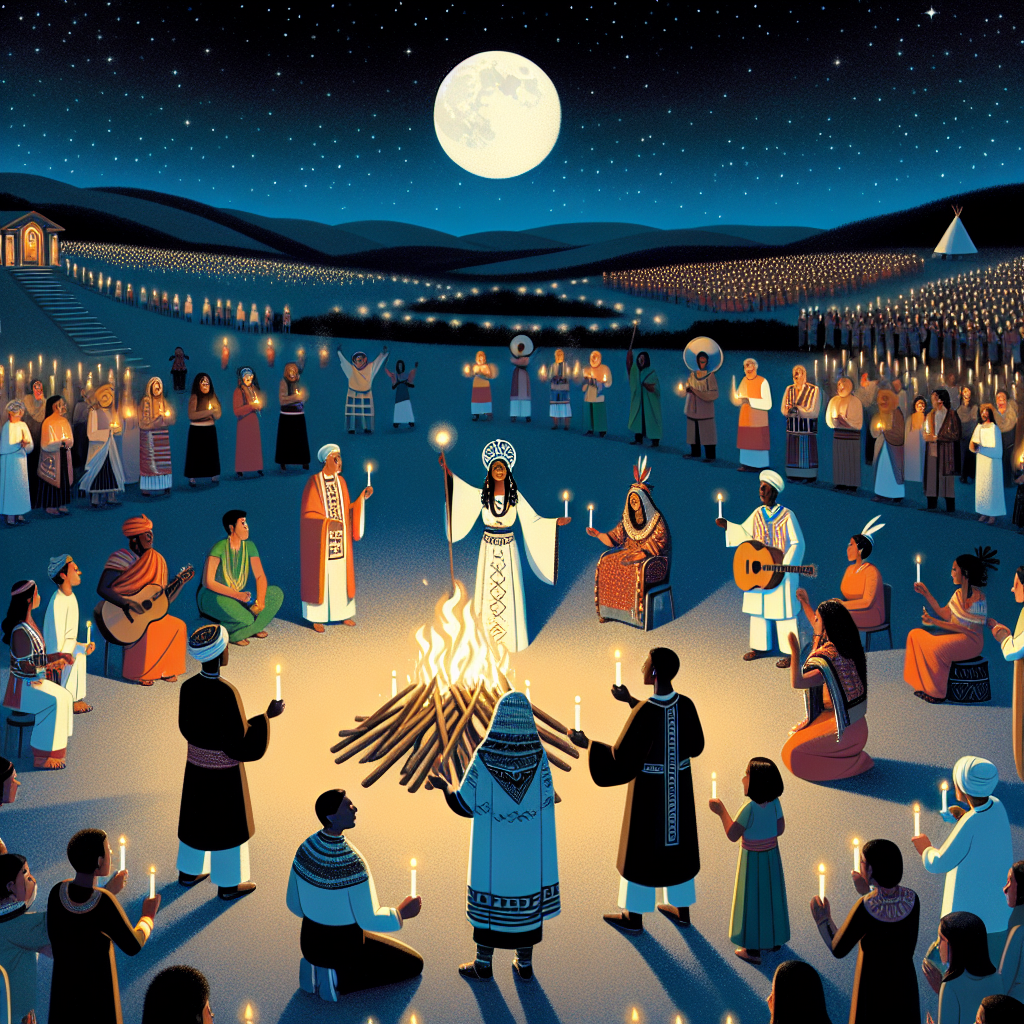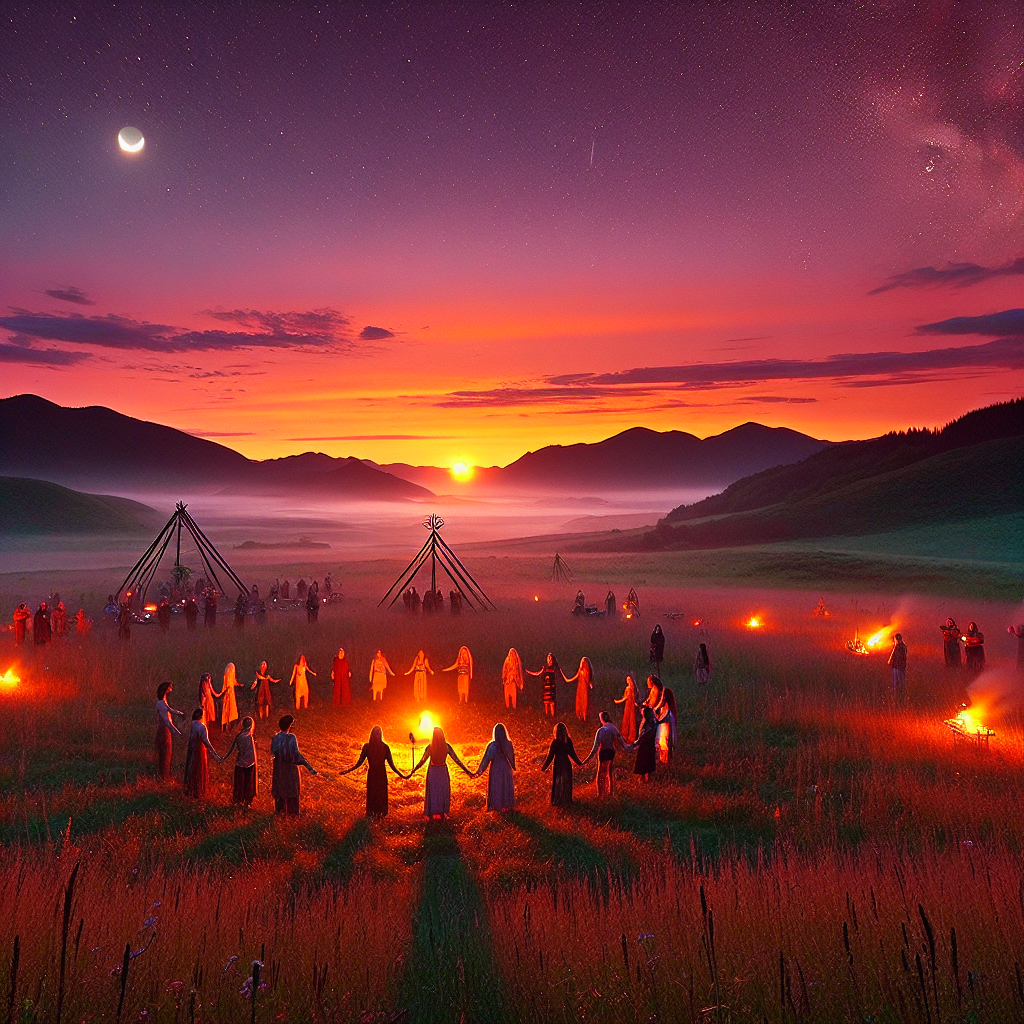As an Amazon Associate I earn from qualifying purchases.

With the longest day of the year in the summer, and the shortest in the winter, solstices have been momentous occasions in many cultures across the world. These natural phenomena, marking a shift in the earth’s orbit and our relationship to the sun, have long been the motivation behind various time-honored traditions and rituals, with the primary intention to reconnect ourselves with nature and our community.
Solstice ceremonies, both those that celebrate the summer (June in Northern Hemisphere, December in the Southern) and winter (December in Northern Hemisphere, June in the Southern), go as far back as ancient times, beginning with Stone-Age societies. As our ancestors were heavily dependent on the rhythms of nature for their survival and prosperity, this was their way of honoring the power of the sun and the cycles of the earth. In modern times, these ceremonies have evolved, carrying significant cultural importance and being a way for individuals and communities to reconnect with nature, their past, and with each other.
Expressions of these traditions, often referred to as Solstice Celebrations, vary widely geographically and culturally, but share common themes. Rituals, such as the creation of altars, bonfires, dances, communal feasts, and more, are often incorporated, symbolizing a manifestation of gratitude, rebirth, or cleansing, signaling the beginning or end of the solar cycle. The summer solstice, associated with abundance, fertility, and light, usually involves celebrations that revolve around basking in the vitality and life-giving properties of the sun. The winter solstice, on the other hand, denotes the shortest day in the year, symbolizing a time of introspection, regeneration, and contemplation of the quiet power found in darkness.
The involvement in these rituals has been found to have profound psychological benefits. According to a study published in the International Journal of Transpersonal Studies, participants of these rituals reported a significant increase in feelings of social cohesion, connectedness, and life satisfaction. This helps us understand why many choose to participate in modern adaptations of these ceremonies, whether physically in group gatherings, or virtually, with the help of modern technology.
In contemporary society, as we face a world where many individuals feel disconnected due to the quick pace of modern life, the desire for an authentic return to nature is very much present. This has triggered a resurgence in the popularity of solstice ceremonies. For many, these simple but significant rituals offer a moment to slow down, to reconnect with the cyclical rhythm of nature, and to experience a powerful sense of belonging, at once uniting us with the cosmos and our community. The use of rituals, both ancient and new, serves as a vehicle to traverse the terrain of human experience, linking past and present, whilst consecrating the sacred wheel of life and light that spins through time and cosmos, renewing the bond between earth and mankind.
What Are Solstice Ceremonies? Exploring Traditions and Rituals to Reconnect
Solstice ceremonies, deeply rooted in a blend of cultural tradition and spiritual beliefs, are special gatherings or rituals held during the summer and winter solstice. These old-world rites are prevalent in various cultures across the globe, and are often primed to honor the cyclical nature of our planet and its relationship with the sun. They also provide an opportunity for individuals to reconnect with themselves, their communities, and the natural world. Ranging from contemplative sunrise vigils to exuberant communal feasts, these ceremonies carry profound symbolism and purpose. However, in today’s fast-paced, modern world, many individuals may find themselves disconnected from these meaningful traditions. Read on to discover more about the rich tapestry of solstice ceremonies and how engaging in these ancient practices can bring benefit to modern day lives.
Solstice ceremonies are deeply entrenched in human history, with nearly every civilization having some form of tradition or ritual to mark this significant event. These traditions and rituals provide a moment to reconnect with the world, acknowledging the energy of the sun as it reaches its highest or lowest point in the sky during the summer and winter solstices respectively.
Understanding Solstice Ceremonies
The sun has long been venerated across cultures, assumed as a sign of life, vitality, and abundance. Solstice ceremonies are performed as a way to align our energies with the energy of the sun. These ceremonies often include meditation, reflection, and setting intentions for the upcoming season. While these traditions have been passed down within various cultures, their central theme remains the same – to celebrate the energy and power of the sun.
Summer Solstice Rituals
The summer solstice, also known as Litha in Pagan traditions, marks the longest day of the year. It is a time of rejoicing in the abundance of light and life. Many solstice ceremonies involve the use of bonfires to represent the full power of the sun. Dancing, singing, and feasting around this fire are common activities. Solstice altars are also created, often decorated with flowers, greenery, and symbols of the sun.
In North America, the Native American tribes hold Sun Dance ceremonies which coincide with the solstice. It is an opportunity for tribes to come together in celebration, prayer, and to reinforce their connections with each other and the earth.
The winter solstice, or Yule in Pagan traditions, is conversely the shortest day of the year, symbolizing a time of introspection and preparation for the upcoming warmer days. Themed around the rebirth of the sun, winter solstice ceremonies often involve the lighting of candles or yule logs.
In East Asian cultures, the Dongzhi festival is celebrated during the winter solstice. It is a time for families to gather and enjoy meals together. One of the most traditional foods eaten during this festival is Tangyuan, sweet rice balls which symbolize reunion.
Celebrating Solstice Today
Today, solstice ceremonies are observed in different ways across the world, yet they maintain their original essence of celebrating the sun and our connection with it. Whether you choose to hold a simple meditation in the early morning as the sun rises or participate in a larger community event, solstice ceremonies can be a way to reconnect with the rhythm of the natural world. Independent of one’s belief system, these ceremonies can provide a sense of grounding and connectedness in an increasingly disconnected world.
To back up the pervasiveness and continued relevance of these traditions, a 2019 study published in Current Anthropology mentioned that monuments like Stonehenge in England and Newgrange in Ireland that align with the solstices are still major gathering places for annual solstice ceremonies. This reflects the timeless human need to reconnect with nature and the cosmos in our rapidly changing times.
Q1: What is a solstice ceremony?
A1: A solstice ceremony is a celebration or ritual that is conducted during the summer or winter solstice. The solstice itself is a celestial event where the sun is at its highest or lowest point in the sky at noon. These ceremonies are often rooted in ancient cultural traditions and are aimed to commemorate this unique time of the year.
Q2: Why do people celebrate the solstices with ceremonies?
A2: Solstice ceremonies are considered significant because they mark the changing of the seasons. They’ve been celebrated for thousands of years by numerous cultures as a way to maintain a connection with the natural world, pay homage to the sun, and usher in a fresh start or a period of reflection.
Q3: What are some common solstice ceremony traditions?
A3: Solstice ceremony traditions can vary greatly depending on the culture. Common elements might include bonfires, dances, feasts, music, and rituals involving the sun. Some cultures also engage in spiritual or healing processes and meditation.
Q4: How can I organize my own solstice ceremony?
A4: To organize a solstice ceremony, begin by choosing the traditions or elements that resonate with you most, and then plan your ceremony around those. You may want to incorporate symbols of nature, music, food, meditation, a bonfire, or a gathering of friends and family.
Q5: Are solstice ceremonies tied to any specific religions?
A5: Solstice ceremonies are not tied to one specific religion. While some may relate them to Pagan or Celtic traditions, they are observed by numerous different cultures and can be celebrated by anyone, regardless of religious beliefs.
Q6: Are there any particular foods associated with solstice ceremonies?
A6: The food associated with a solstice ceremony can greatly depend on cultural traditions. Certain fruits and vegetables that are in season during the solstice are often incorporated, as well as grains, honey, and drinks like mead or wine.
Q7: Can children participate in solstice ceremonies?
A7: Yes, children can participate in solstice ceremonies. In fact, they often enjoy the merriment and spectacle of these celebrations. Depending on the nature of the specific traditions being observed, some parts may be more appropriate for adults, but many elements can be shared and enjoyed by the whole family.
Q8: Can I join in a solstice ceremony if there isn’t one near me?
A8: If you’re unable to find a public solstice ceremony near you, you can certainly create your own personal celebration, or celebrate virtually with an online community.
Q9: How long does a solstice ceremony typically last?
A9: The length of a solstice ceremony can vary significantly. It can range from a few hours to an entire day and night, depending on the specific traditions being observed. Some people even celebrate across multiple days.
Q10: Is there a right or wrong way to celebrate a solstice?
A10: There’s no right or wrong way to celebrate a solstice. The most important thing is to choose a celebration method that feels meaningful and significant to you. If you prefer a quiet, personal ceremony, that’s just as valid as a large, communal celebration.

Conclusion: The Power and Symbolism of Solstice Ceremonies
Solstice ceremonies function as powerful tools for reconnection and reflection. They mark the biannual points in Earth’s orbit where the sun reaches its highest or lowest point relative to the equator. Across cultures, these moments have typically served a dual purpose: they both honor the sun’s primal role as life-bringer and illuminate our place within the astronomical whole. Regardless of cultural background, these communal and personal ceremonies deepen our connection to nature and each other, and remind us to live mindfully.
They also offer a stage to bridge various practices and traditions. The solstice may be celebrated with roaring bonfires, silent meditation, or even hearty feasts, and each custom reflects the complex diversity of human culture. Furthermore, modern iterations of these ancient ceremonies carry forward their foundational message – the importance of balance, the preciousness of life, and the beauty of transition. These transformative experiences can support individuals on their personal spiritual journeys and contribute to a global understanding of unity and interconnectedness.
Amazon and the Amazon logo are trademarks of Amazon.com, Inc, or its affiliates.


